The Museum invites you to an Open House.
Step inside and enjoy some of the exhibits in the world's first museum of psychedelic history.
Dr. Albert Hofmann
|

Dr. Albert Hofmann |
This is a photograph, taken about ten years ago, of Albert Hofmann, the master chemist from whom the museum gets its name. Dr. Hofmann is the museum's patron. Hofmann synthesized LSD in 1938 and again in 1943. He was the first human subject to experience its effect. He later isolated and synthesized psilocybin, the active ingredient of the Psilocybe mexicana mushroom, sacred to the Huichol. The photograph is signed by Hofmann and inscribed in his own hand with the chemical formulae of LSD and psilocybin.
- Gift of Albert Hofmann |
Blotter Sheet Signed by Allen Ginsberg
|
Here is a piece from the museum's collection of blotter art. LSD was distributed from the late sixties on sheets of blotter imprinted with colorful designs. The term "blotter art" refers to the design feature of such sheets. Value is added when a blotter sheet bears the signature of a well-known personality. (Note: the museum's sheets of blotter were tested and found negative for the presence of active chemical.)
This is a rare print from a small series signed by Allen Ginsberg and presented to the museum shortly before the poet's death. A Hindu deity couple embrace in an expression of ecstatic knowledge.
- Gift of Allen Ginsberg |
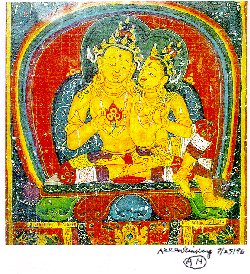
Blotter Sheet Signed by Allen Ginsberg
|
Two Small Paintings
Turn now to a set of paintings done on canvas board in 1960 in
the course of a psychedelic experience. The set is entitled "The Emergence of
Form." Of the two pieces shown here, that on the left is untitled; the title
of the painting on the right is "Flower." The psychedelic agent used at the
time was LSD, dose not recorded. Artist's name withheld. The paintings are characteristic
of experiments in the field of creativity popular at the time.
- Archives of the Albert Hofmann Foundation
|

Small Painting #1
|

Small Painting #2
|
The Kachina Doll Paintings
Two example from the famous collection of paintings done under
the influence of LSD, part of a creativity study conducted by Oscar Janiger
in Los Angeles in the mid-fifties. In the experiment, artists were asked to
reproduce a Hopi kachina doll. Results ranged from concrete to abstract, correlating
with the length of time into a session.
- On loan from Oscar Janiger
|
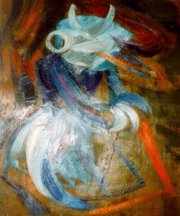
Kachina Doll Painting #1
|

Kachina Doll Painting #2
|
Photo of Albert Hofmann and Timothy Leary
|
Albert Hofmann and Tim Leary pose in a Hamburg TV studio in 1993.
Original photograph signed by Albert Hofmann and inscribed "(with my
friend Tim Leary 16/7/93 in Hamburg) (G)"
- Donor John Beresford
|
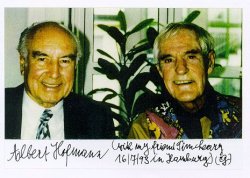
Photo of Albert Hofmann and Timothy Leary
|
Cover and Inside Pages of Comic Book
Timothy Leary was one of the great figures of the psychedelic
era, possibly the most influential, and certainly the most controversial. This
hard-to-find comic book explains Leary's 8-circuit theory of human evolution
that he called "Neurologic," and is signed by Leary himself. The comic was published
in 1979 by Last Gasp Eco-Funnies of San Francisco. Front and back cover, painting
by Tim Kummem. Inside front cover and first page of text.
- Gift of Peter Stafford
|
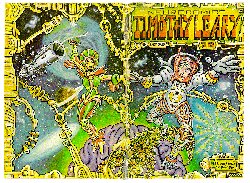
Cover and Last Page of Leary Comic Book
|
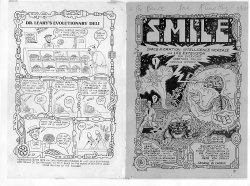
Inside Pages of Leary Comic Book
|
Sandoz Library
|
A major acquisition to the museum's collection came in 1996 with
the transfer to Los Angeles of the library formerly in the Sandoz archive
in Switzerland. This compilation of the world's scientific literature
on LSD and psilocybin begins with the first published reference to LSD
(1947) and continues virtually without a break into the late eighties.
The 93 volumes contain nearly 4,000 reprints, some not yet translated
into English.
- Donor Anonymous
|
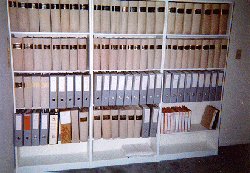
The Sandoz Library
|
A Schultes Monograph
|
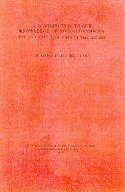
The Red Booklet Cover
|
This is a mint copy of the 1941 monograph by Richard Evans Schultes,
published by the Botanical Museum of Harvard University: A Contribution
to Our Knowledge of Rivea Corymbosa. The ground- breaking work on the
ololiuqui morning glory plant includes the observation "Without any
doubt, the most important use of Rivea corymbosa was and is as a narcotic
for divination. The seeds were widely used for this purpose among the
ancient Aztecs and are still used for divination among many Indians
of southern Mexico. In the three hundred years [since the Spanish Conquest],
the methods and purposes of using ololiuqui have undergone but slight
changes" (p.25) - a remarkable assertion for a scientific publication
of the time!
- Albert Hofmann Foundation archives |
The POW Marijuana Leaf Poster
|
Last on today's guided tour of the museum, you see the poster
designed for the First International Conference on Drug War Prisoners
in Heidelberg, Germany, in 1996. A frolicsome cannabis leaf rejoices
at the entrance of the sun's rays through prison bars. Translated, the
heading reads "No Prison for Drugs!"
- Gift of Werner Pieper
|
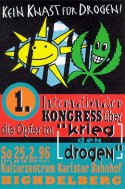
POW Marijuana Leaf Poster
|
Please take this reminder with you as you leave. The museum does not advocate the use by anyone of an illegal substance. Nor does it advocate abstinence from an illegal substance. The museum is not in the business of advocating anything. It is a museum, first and foremost, dedicated to the preservation of historical material, education in the field of psychedelic history, and the pursuit of scholarly research.
Come again, and check out new additions!
Home | About
Us | Culture | Events
| Links | Museum
| Projects | Reviews
| Science | Voices
| What's New











